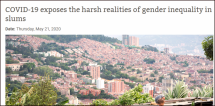COVID-19 Exposes the Harsh Realities of Gender Inequality in Slums
The COVID-19 pandemic is largely concentrated in cities and urban areas, with around 2,600 cities globally reporting at least one case of the disease. While the epicentre of the global health crisis is still Europe and North America, its impact on developing countries may be more devastating, especially for the poorest. The 1 billion+ people living in slums and slum-like settings in developing countries, where population density is high, are those most at-risk and least prepared.
Most countries have responded with shelter-in-place orders, lockdowns and measures to curtail COVID-19’s spread. But slum-dwellers will have a hard time complying, as their overcrowded housing often lacks basic utilities, like water and sanitation. For women and girls who are slum-dwellers, the challenges are even greater as they face increased domestic violence (already being reported) and unpaid care burdens.
Women aged 15 to 49 are overrepresented in urban slums and slum-like settings in 80 per cent of the 59 developing countries analysed in a Spotlight on Goal 11 paper, produced by UN Women and UN-Habitat. In Kibera, Kenya, the world’s fourth-most-populated slum – and where COVID-19 cases are highest in East Africa – there are 116 women for every 100 men. The figure is 120+ women per 100 men in Gabon, Ghana, Guatemala, Haiti and Lesotho. In 61 per cent of the 59 developing countries analysed, more than half of women aged 15–49 live in slums.
Last modified: August 12, 2021
Language: English

